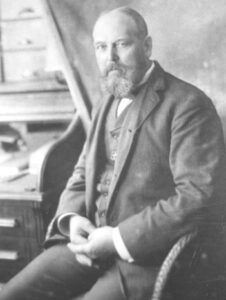
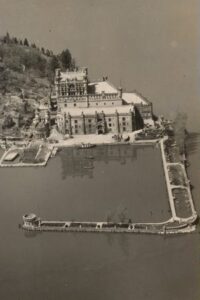 We don’t often think of the United States having castles, but some do exist. Most are not considered true castles, but are rather country houses, follies, or other types of buildings built to give the appearance of a castle. In architecture, a folly is a building constructed primarily for decoration, but suggesting through its appearance some other purpose, or of such extravagant appearance that it transcends the range of usual garden buildings. Castles seem like almost ancient history items to most of us, and when it came to the United States, many people thought of the Old West and homestead type dwellings. Nevertheless, there are a few real castles here in the United States, even if we don’t have royalty here.
We don’t often think of the United States having castles, but some do exist. Most are not considered true castles, but are rather country houses, follies, or other types of buildings built to give the appearance of a castle. In architecture, a folly is a building constructed primarily for decoration, but suggesting through its appearance some other purpose, or of such extravagant appearance that it transcends the range of usual garden buildings. Castles seem like almost ancient history items to most of us, and when it came to the United States, many people thought of the Old West and homestead type dwellings. Nevertheless, there are a few real castles here in the United States, even if we don’t have royalty here.
One such castle is Bannerman Castle in New York. The castle is located on Pollepel Island, about 50 miles north of New York City, on the Hudson River. The castle is in serious disrepair, but the Bannerman Castle Trust, Inc is trying to shore up the buildings so they don’t deteriorate further. The analysis that has been done indicates that 5 out of the 7 buildings on the island could be shored up. The others are too far gone. The castle has a strange history, and I suppose some would debate it’s claim as a true castle. The castle was built by Frank Bannerman VI over a period of 17 years. The island’s buildings were personally designed by Bannerman without professional help from architects, engineers, or contractors. The island has buildings, docks, turrets, garden walls, and a moat in the style of old Scottish castles. That was his passion. He loved Scottish castles and built his castle with a Scottish flare. All of the buildings are elaborately decorated, from biblical quotations cast into all fireplace mantles, to a shield between the towers with a coat of arms, and a wreath of thistle leaves and flowers.
Bannerman’s family immigrated to America in 1854, when he was three. They settled in Brooklyn, New York, where his father established a business selling flags, rope, and other articles acquired at Navy auctions. He was a patriotic man, who joined the union army during the Civil War. At that time young Frank began running the business. He was 13 years old. When the Civil War ended, the US government auctioned off military goods by the ton, mostly to be scrapped for their metal. It was young Frank who saw the importance of these materials, and it was his wise purchases that earned him the moniker “Father of the Army-Navy Store.” He could see that much of what was being sold had a market value higher than scrap. Under the guidance of the younger Bannerman, the Bannerman family became the world’s largest buyer of surplus military equipment. By this time, their storeroom and showroom took up a full block at 501 Broadway. Bannerman made his store into a type of museum/store. It opened to the public in 1905. Of it, the New York Herald said, “No museum in the world exceeds it in the number of exhibits.”
Frank was very prosperous, and it was during a business trip to Ireland that he met his future wife, Helen Boyce. They had three children. At the close of the Spanish American War, Frank Bannerman purchased 90 
 percent of all captured goods in a sealed bid. After that, it became necessary to find a secure place to store their large quantity of very volatile black powder. His son, David saw Pollepel Island, in the Hudson, and Frank Bannerman purchased it in 1900. Following the purchase, the building of the castle began. Today, the island is owned by the state of New York, and at this time visits are prohibited until the buildings can be made safer.
percent of all captured goods in a sealed bid. After that, it became necessary to find a secure place to store their large quantity of very volatile black powder. His son, David saw Pollepel Island, in the Hudson, and Frank Bannerman purchased it in 1900. Following the purchase, the building of the castle began. Today, the island is owned by the state of New York, and at this time visits are prohibited until the buildings can be made safer.

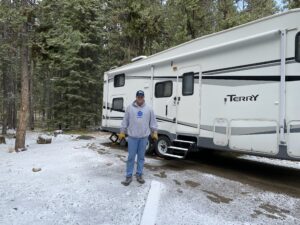 My nephew, Ryan Hadlock is such a good husband, dad, uncle, brother, and son. His wife, Chelsea tells me that he has worked very hard to become an expert at fixing his truck and their camper. They worked a lot on their house getting it fixed up the way they want it too. Ryan has been organizing the garage and shed and really making their house, their home. His sister, Jessi Sawdon tells me that over the past several years, Ryan has really embraced being “the only boy out of the four siblings” and helped each of his sisters to fix things in their homes. He has helped with their kids, and lending an ear whenever they need it. His sister, Kellie Hadlock said, “He is always taking care of me and showing up right when I need his help! Johnny on the spot when I call him!! Never expecting anything in return.” His mom, Allyn Hadlock said, “He’s such a great son to us! Always willing to come out and help with anything we need, whether it’s helping Chris lift stuff or digging a ditch, Ryan always comes when we ask.” Lindsay, Kellie and Jessi are so blessed to have a brother who is also their best friend.
My nephew, Ryan Hadlock is such a good husband, dad, uncle, brother, and son. His wife, Chelsea tells me that he has worked very hard to become an expert at fixing his truck and their camper. They worked a lot on their house getting it fixed up the way they want it too. Ryan has been organizing the garage and shed and really making their house, their home. His sister, Jessi Sawdon tells me that over the past several years, Ryan has really embraced being “the only boy out of the four siblings” and helped each of his sisters to fix things in their homes. He has helped with their kids, and lending an ear whenever they need it. His sister, Kellie Hadlock said, “He is always taking care of me and showing up right when I need his help! Johnny on the spot when I call him!! Never expecting anything in return.” His mom, Allyn Hadlock said, “He’s such a great son to us! Always willing to come out and help with anything we need, whether it’s helping Chris lift stuff or digging a ditch, Ryan always comes when we ask.” Lindsay, Kellie and Jessi are so blessed to have a brother who is also their best friend.
Ryan is the only son of my sister, Allyn and her husband, Chris, so he knows how to tease, help, and be kind to his sisters. Ryan might say he’s “mean” to them, but he’s a teddy bear. He’s fun loving, just like his dad. He is a 
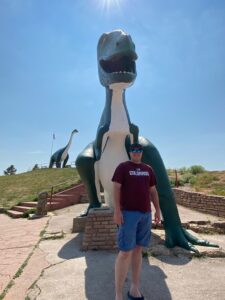 great uncle to nieces, Adelaide Sawdon and Mackenzie Moore. He is always ready to play with them when they are all together. The girls love to try to get him to catch them. Ryan’s children, Ethan and Aurora Hadlock are getting bigger now, so the things Ryan does with them have changed a bit. Recently, Ryan and Ethan have been working on customizing Ethan’s computer, and Aurora will always be Daddy’s Girl.
great uncle to nieces, Adelaide Sawdon and Mackenzie Moore. He is always ready to play with them when they are all together. The girls love to try to get him to catch them. Ryan’s children, Ethan and Aurora Hadlock are getting bigger now, so the things Ryan does with them have changed a bit. Recently, Ryan and Ethan have been working on customizing Ethan’s computer, and Aurora will always be Daddy’s Girl.
The whole Hadlock family loves to go camping, and some years find them camping more than others, Nevertheless, they all managed to get together a couple of times. Ryan and Chelsea probably got more camping in this year than the rest of the family. Jessi’s family was getting ready to move from Casper to Cheyenne, so they were packing and getting their new home ready. Ryan, Chelsea, and their kids have visited Jessi and Jason in Cheyenne, as well as Lindsay and Shannon in Laramie, for some quality time with the family.
Ryan has really been digging into God’s Word too. He’s really been a light to his kids and everyone he comes in contact with the things the Lord has taught him. Each time I see him he is walking the walk of faith and talking the talk of faith. You can’t be more proud of something than that. He has become a wealth of knowledge to his family about Jesus. He and his family take time to study. He had committed himself to the Lord and it is a blessing to get to talk with Him about the Lord! He spends a lot of time listening to Kenneth Copeland Ministries, Joel Osteen, and Joseph Prince, and then he goes out and shares what he learned with the family. He loves and lives what he is learning!
He’s a happy guy with a great attitude and a great love for the Lord. He likes to play guitar with his dad, Chris. 
 When his parents had their new home built, the put in a dedicated music room. Ryan and Chris have been having some good sessions in the music room together. In December, Ryan and his dad have planned a father/son trip…just the two of them for some male bonding time, and of course being guys means it must include sports, so they will be attending a Broncos game. I know they will have a great time. Today is Ryan’s birthday. Happy birthday Ryan!! Have a great day!! We love you!!
When his parents had their new home built, the put in a dedicated music room. Ryan and Chris have been having some good sessions in the music room together. In December, Ryan and his dad have planned a father/son trip…just the two of them for some male bonding time, and of course being guys means it must include sports, so they will be attending a Broncos game. I know they will have a great time. Today is Ryan’s birthday. Happy birthday Ryan!! Have a great day!! We love you!!
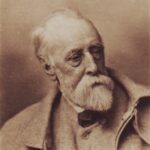 When someone sacrifices their life to save the life of another, its big news for a while, but eventually only the one who was saved, and maybe their family, remember the name of that selfless hero. In 1887, sculptor, George Frederic Watts, who thought that loss of memory concerning these heroes was horribly sad and just plain wrong, proposed a memorial to honor these forgotten heroes.
When someone sacrifices their life to save the life of another, its big news for a while, but eventually only the one who was saved, and maybe their family, remember the name of that selfless hero. In 1887, sculptor, George Frederic Watts, who thought that loss of memory concerning these heroes was horribly sad and just plain wrong, proposed a memorial to honor these forgotten heroes.
The Memorial to Heroic Self-Sacrifice is a public monument in Postman’s Park in the City of London. Watts wanted the memorial to be ready in time to commemorate the Golden Jubilee of Queen Victoria. Unfortunately, the project was not accepted at that time, but in 1898 Watts was approached by Henry Gamble, vicar of Saint Botolph’s Aldersgate church. Postman’s Park was built on the church’s former churchyard, and the church was trying to raise funds to secure its future. That was when Gamble heard about the memorial project inspired by Watts. Gamble felt that Watts’ proposed memorial would raise the profile of the park…make it more memorable. Because it was going to be an ever-evolving memorial, it was unveiled in an unfinished state in 1900. The memorial consisted of a 50-foot wooden loggia designed by Ernest George. A loggia is an 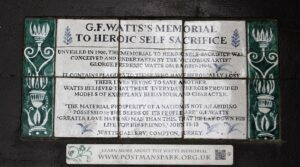 architectural feature which is a covered exterior gallery or corridor usually on an upper level, or sometimes ground level. The loggia sheltered a wall with space for 120 ceramic memorial tiles to be designed and made by William De Morgan. At the unveiling, only four of the memorial tiles were in place.
architectural feature which is a covered exterior gallery or corridor usually on an upper level, or sometimes ground level. The loggia sheltered a wall with space for 120 ceramic memorial tiles to be designed and made by William De Morgan. At the unveiling, only four of the memorial tiles were in place.
Watts died in 1904, before his idea was really in it’s full glory. His widow, Mary Watts took over the running of the project. In 1906, after making 24 memorial tablets for the project, William De Morgan abandoned the ceramics business to become a novelist. It was a bit of a blow to the project. The only ceramics firm able to manufacture appropriate further tiles was Royal Doulton. Mary was dissatisfied with Royal Doulton’s designs, and preoccupied with the management of the Watts Gallery and Watts Mortuary Chapel in Compton, Surrey. Eventually, Mary Watts lost interest in the project. Work to complete it was sporadic and ceased altogether in 1931 with only 53 of the planned 120 tiles in place. I think it is very sad that such an amazing project was sidelined…for lack of interest!! Seriously, lack of interest!! Finally, in 2009, the Diocese of London consented to 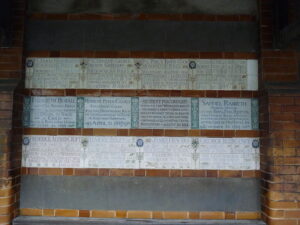 further additions to the memorial, and the first new tablet in 78 years was added. In my opinion, it’s about time.
further additions to the memorial, and the first new tablet in 78 years was added. In my opinion, it’s about time.
As interest grew again, a mobile app was created in 2013. It was called The Everyday Heroes of Postman’s Park. Once again, interest wained…at least for the app, so it is now discontinued. The app provided a detailed account of the fifty-four incidents commemorated on the Memorial when a visitor scanned its plaque with a handheld device. Again, I find myself feeling sad that people can possible lose interest in the everyday heroes in our world. They are each amazing, and they should never be forgotten.

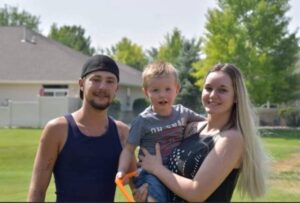 My nephew, Riley Birky has had a rough year, as has his whole family. The 2020 year began with the loss of his mom, Rachel Schulenberg, to a stroke. Rachel’s loss has changed Riley in many ways. Like most teenagers, Riley has gone through his share of wild times, but now he wants to make his mom proud of him. Now, he is on the other side of that old life, and moving forward into a better life. That said, Riley has been spending the last year really getting his life together, and really making a fresh start. Every day finds Riley trying to become a better person. He wants to be a and upstanding citizen, who is working for society. Every kid makes mistakes, and Riley is trying to make up for his.
My nephew, Riley Birky has had a rough year, as has his whole family. The 2020 year began with the loss of his mom, Rachel Schulenberg, to a stroke. Rachel’s loss has changed Riley in many ways. Like most teenagers, Riley has gone through his share of wild times, but now he wants to make his mom proud of him. Now, he is on the other side of that old life, and moving forward into a better life. That said, Riley has been spending the last year really getting his life together, and really making a fresh start. Every day finds Riley trying to become a better person. He wants to be a and upstanding citizen, who is working for society. Every kid makes mistakes, and Riley is trying to make up for his.
Riley is really moving into adulthood in a big way. He has been with his girlfriend, Sierah Martin for over a year now, and he is working hard to make a good home for her and her son, Jace. Riley is working hard to being a good father figure for Jace. Riley working full-time to help support them, and often takes on odd jobs to give them a better life. He has also been being a good uncle to his nephew, Lucas and niece, Zoey, babysitting all the kids at his sister, Cassie Franklin’s house. Riley really enjoys time with his family. They play video games like Spyro the dragon. And, they share precious family times together. He has also been enjoying his dog, Nala, who came from his sister, Cassie’s dogs, Buddy and Maya. As we all know, a dog is man’s best friend.
Riley is pretty handy, so in his spare time he’s been helping his friend renovate their camper. Most renovation 
 jobs take more than one person, and a camper is no different. I’m sure his friend really appreciates the help Riley has been giving. A great friend aids a friend in need, and that is what Riley is…a great friend.
jobs take more than one person, and a camper is no different. I’m sure his friend really appreciates the help Riley has been giving. A great friend aids a friend in need, and that is what Riley is…a great friend.
Riley definitely misses his mom, but I know without a doubt that she would be so very proud of him. I can’t take away the pain of missing her, Riley, but I promise you…she is very proud of the man you have become. Today is Riley’s 21st birthday. Happy birthday Riley!! Have a great day!! We love you!!

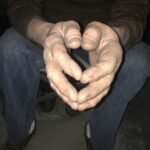
 This has been an interesting year for my nephew, Steve Moore. Steve enjoys doing things with his hands, and on March 5, 2021, he managed to get twisted up in the lathe. It happened to be the same day his father-in-law, LJ Cook was having back surgery, and the day his uncle, Ron Schulenberg was visiting, so thankfully there was someone there to help. things could have turned out much worse for Steve, but he got out of it just in time before it did more damage. Steve had to go through occupational therapy to repair the torn muscles. His hand will take a while to get back to where it was, but he has his hand and the use of it, and that is a huge blessing.
This has been an interesting year for my nephew, Steve Moore. Steve enjoys doing things with his hands, and on March 5, 2021, he managed to get twisted up in the lathe. It happened to be the same day his father-in-law, LJ Cook was having back surgery, and the day his uncle, Ron Schulenberg was visiting, so thankfully there was someone there to help. things could have turned out much worse for Steve, but he got out of it just in time before it did more damage. Steve had to go through occupational therapy to repair the torn muscles. His hand will take a while to get back to where it was, but he has his hand and the use of it, and that is a huge blessing.
Steve was still recovering, when his company held their “late” Christmas party (lots of late Christmas parties this past year). They had decided to go to a place in Cody (Steve lives in Powell, Wyoming) called Cody Firearms Experience. Apparently they couldn’t have picked a better place, because everyone thought this place was very cool. Cody Firearms Experience offers practice ranges for shooting any gun, and they would have had Steve at that point for sure, but you can throw axes/tomahawks!! They give lessons, if you need them. Steve and his wife, my niece, Machelle Moore went back a couple times and that’s all it took. Steve is hooked. Steve and Machelle love to go camping, and so tomahawk throwing has become a part of the camping experience. He has gotten really good by practicing at camp and in their back yard.
In a normal year, Steve can be found helping his father-in-law and anyone else who needs help, cutting firewood, or just about whatever else is needed, but right now, he can’t stand any vibration on his hand. He even has a hard time running the weed eater, but he does get that done in their yard. That said, he had to take the summer off from trying to help his father-in-law get firewood for the winter. LJ found a guy that brought him some wood for the winter. It was already cut and split, so that was nice. Steve plans to work hard this winter to get his had back in shape for next summer. He is hoping he will be confident enough next summer to run the chainsaw. The chainsaw takes strength and hand control, so time will tell.
In the meantime, Steve has picked up the new hobby of throwing knives and tomahawks. His boys, Weston and Easton Moore love it too. It has been something that is a lot of fun for Steve and the boys to “bond” over. Then his work supervisor had a buddy that supplied them with some wood to throw in. They made some really nice targets. Since Weston lives in Butte, Montana now, Easton has had more time throwing, because he still lives at home. Steve even got the neighbor into throwing tomahawks. Then the neighbor brought over old kitchen knives to try. That didn’t work too well. They all ended up breaking. I guess kitchen knives weren’t designed for throwing at a wooden target. Steve ordered the good knives, and now they have knives to throw that don’t break. They are made of muck heavier metal. The tomahawks they used are hand forged, hand made out of Ohio…which prompted me to suggest that Steve needs a forge of his own. Machelle likes the idea, so I expect to see that going on in the future.
Steve and his family have been hiking in the Big Horn Mountains for twenty years, and going part way up one hill most of that time. They just love the area. This summer they hiked up higher up the hill than they had ever gone before and came across a replica (similar anyway) to the famous “Medicine Wheel” that is up there. They really like the are, because of the dark red dirt. They were hiking a different route, and ended up going to the top on the back side. As they were headed back to the truck, they found this wheel. When they got out the 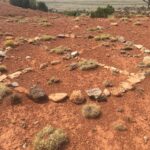
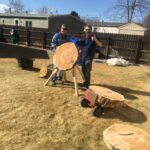
 compass, they found that, sure enough, the lines are exact north, south, east and west. They felt like they had found a real gem. Steve and Machelle love being out in the mountains, so I wouldn’t be surprised if they find the other wheels they have heard are out there. Today is Steve’s birthday. Happy birthday Steve!! Have a great day!! We love you!!
compass, they found that, sure enough, the lines are exact north, south, east and west. They felt like they had found a real gem. Steve and Machelle love being out in the mountains, so I wouldn’t be surprised if they find the other wheels they have heard are out there. Today is Steve’s birthday. Happy birthday Steve!! Have a great day!! We love you!!
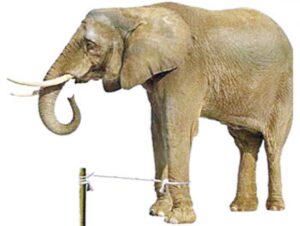
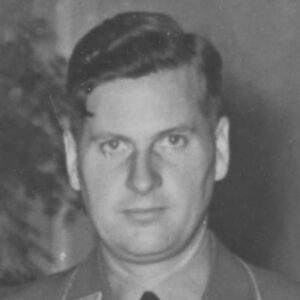 I read a story about training an elephant yesterday. It went like this, “As a man was passing the elephants, he suddenly stopped, confused by the fact that these huge creatures were being held by only a small rope tied to their front leg. No chains, no cages. It was obvious that the elephants could, at anytime, break away from their bonds but for some reason, they did not.
I read a story about training an elephant yesterday. It went like this, “As a man was passing the elephants, he suddenly stopped, confused by the fact that these huge creatures were being held by only a small rope tied to their front leg. No chains, no cages. It was obvious that the elephants could, at anytime, break away from their bonds but for some reason, they did not.
He saw a trainer nearby and asked why these animals just stood there and made no attempt to get away. ‘Well,’ trainer said, ‘when they are very young and much smaller we use the same size rope to tie them and, at that age, it’s enough to hold them. As they grow up, they are conditioned to believe they cannot break away. They believe the rope can still hold them, so they never try to break free.’
The man was amazed. These animals could at any time break free from their bonds, but because they believed they couldn’t, they were stuck right where they were.”
The story made me think about the way Hitler was able to train a generation to follow him without question. He took the children away from their parents when they were young, basically telling the parents that the state knew what was best for the children, and the parents didn’t know enough about educating the children to do a good job. He set up the Hitler Youth organization in 1933 for educating and training male youth in principles. Of course, the principles Hitler had in mind were vastly different from any that the parents could imagine. Hitler’s ideas included racism, killing any “undesirables” among the population, and controlling the people with curfews and lockdowns…to name a few. Under the leadership of Baldur Benedikt von Schirach, the head of all German youth programs, the Hitler Youth included by 1935 almost 60 percent of German boys. On July 1, 1936, it became a state agency that all young “Aryan” Germans were expected to join. Upon reaching his 10th birthday, a German boy was registered and investigated especially for “racial purity” and, if qualified, inducted into the “German Young People.” At age 13 the youth became eligible for the Hitler Youth, from which he was graduated at age 18. Throughout these years he lived a life of dedication, fellowship, and Nazi conformity, generally with minimum parental guidance. From age 18 he was a member of and served in the state labor service and the armed forces until at least the age of 21.
Two leagues also existed for girls. The League of German Girls trained girls ages 14 to 18 for comradeship, domestic duties, and motherhood. “Young Girls” was an organization for girls ages 10 to 14. The girls were expected to have babies to build the Reich…provided they qualified as “racially pure,” of course.
In the tumultuous days we currently live in, parents need to be very involved in what our children are being taught. The current racially charged climate in our nation would only be exacerbated by teaching our children things like Critical Race Theory, because it is really the new Ku Klux Klan. Racism, against any nationality is simply wrong…there is no gray area. Our children need to be able to be proud of the race they are and the background they come from. Racism is unacceptable, against any race, and we, as parents, grandparents, and 
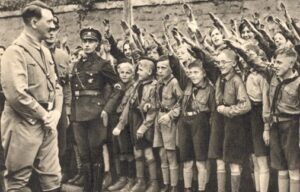 even great grandparents, need to kick the government out of our educational system, and get back to decent moral values. We need to stop the insanity in our schools, and teach our kids the true history of our nation. We must teach good values, and our children need to be taught to accept all races. We need to start with the kids, because they are the future leaders.
even great grandparents, need to kick the government out of our educational system, and get back to decent moral values. We need to stop the insanity in our schools, and teach our kids the true history of our nation. We must teach good values, and our children need to be taught to accept all races. We need to start with the kids, because they are the future leaders.
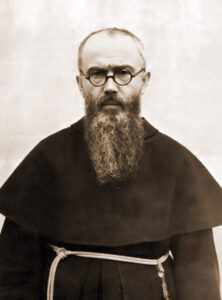 Heroes come from all walks of life, and you really never know who will become a hero and who won’t. In fact, I don’t think a hero even knows that the heroic in inside him, until the heroic is needed. Often the heroic comes from being faced with a situation that would require your life to save that of another. Such was the case for Maximilian Kolbe in 1941.
Heroes come from all walks of life, and you really never know who will become a hero and who won’t. In fact, I don’t think a hero even knows that the heroic in inside him, until the heroic is needed. Often the heroic comes from being faced with a situation that would require your life to save that of another. Such was the case for Maximilian Kolbe in 1941.
The Catholics didn’t really agree with the Jewish beliefs, and the Jews felt the same way about the Catholics beliefs, so when Hitler began rounding up the Jews, many Catholics and other religions, were quick to turn them over…it might have been to save their own lives, but they were handing them over to be killed, nevertheless…and they knew it. The non-Jews could pretend that everything was fine and the Jewish people who were taken, would be returned when things settled down, and maybe at first they truly thought that, but as time went by the truth was coming out. They now had a choice to make…a moral choice.
Kolbe was a Catholic priest during World War II. He saw what was going on with the Jewish people, when Hitler started rounding them up. Kolbe could read between the lines, as many people could in those horrific days, and he decided to help Jewish people escape the Nazis. Being a Catholic priest, he likely had more room that other 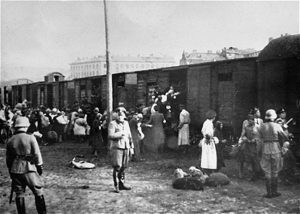 people might have had. He started harboring Jewish people and hiding them from the Nazis, keeping them safe from the public and any harm that might be afflicted upon them. As with many people who harbored Jews, Kolbe was soon caught, and was sent to Auschwitz for sheltering Jewish people.
people might have had. He started harboring Jewish people and hiding them from the Nazis, keeping them safe from the public and any harm that might be afflicted upon them. As with many people who harbored Jews, Kolbe was soon caught, and was sent to Auschwitz for sheltering Jewish people.
Auschwitz was one of the worst of Hitler’s torture chamber death camps, and it certainly proved to be just that for Kolbe. During his time at the horrid concentration camp, a prisoner escaped from the camp and as punishment, ten innocent prisoners had to starve to death in a hollow, concrete tube. One of the elected people started to cry and exclaimed that they had a wife and kids, so Kolbe spoke up and took his place so the man could be with this family. The prisoners were kept in the tube for the next two weeks. Most of them were already in a weakened and starved state, and so the prisoners inside the tube slowly began to die. Of the ten prisoners, Kolbe and 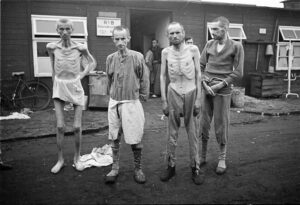 three other men managed to survive the torturous tube. One would think that if they survived the tube, they would be considered strong enough to bring out and put back to work, but the remaining prisoners were brought out of the tube and killed by being injected with Carbolic Acid. When it was his turn to receive the injection, Kolbe didn’t fight like the rest of the men, but instead, he gave his arm to the prison guard and never once made a fuss over it. One might think that Kolbe was just done with the whole mess, and maybe that was true, but it would have made no difference for him to fight. The guards had decided, and his fighting the injection would make no difference. Maximilian Kolbe died on August 14, 1941. He was 47 years old.
three other men managed to survive the torturous tube. One would think that if they survived the tube, they would be considered strong enough to bring out and put back to work, but the remaining prisoners were brought out of the tube and killed by being injected with Carbolic Acid. When it was his turn to receive the injection, Kolbe didn’t fight like the rest of the men, but instead, he gave his arm to the prison guard and never once made a fuss over it. One might think that Kolbe was just done with the whole mess, and maybe that was true, but it would have made no difference for him to fight. The guards had decided, and his fighting the injection would make no difference. Maximilian Kolbe died on August 14, 1941. He was 47 years old.
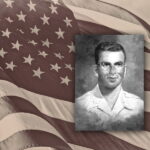 It’s hard to picture a dentist as being a hero, but US Army Medic Ben Salomon, who was a dentist before he was drafted in to the US Army as a private in 1940, as World War II was in its early stages. Salomon was assigned, not to the medical units, but rather, to the infantry. It was in the infantry during rifle and pistol qualifications that Salomon was rated an Expert Marksman. He also had medical knowledge that could be used during battlefield surgery. Salomon was assigned to a unit as their medic. Being a medic in wartime means that you are doing the noble thing, a task which is not often recognized as anything special. I think was have all seen the television show, MASH, in which the position of Army Doctor is viewed as mostly safe, far from the front lines, and given to a little bit of hanky panky. It doesn’t often paint a picture of heroic actions, although, sometimes the doctors are heroic (Nevertheless, I don’t mean to say that all military doctors are like the doctors on MASH, who are, after all, playing a part.) Medics serve and protect like every other serviceman, but they sometimes see a lot more of war’s ugly side. These unit medics might saw torn apart friends, horrific injuries, and a lot of deaths. The men they served with every day were their friends, and while the medic was usually behind the unit in a tent, caring for the wounded, these were not strangers to them. They were friends and comrades in arms.
It’s hard to picture a dentist as being a hero, but US Army Medic Ben Salomon, who was a dentist before he was drafted in to the US Army as a private in 1940, as World War II was in its early stages. Salomon was assigned, not to the medical units, but rather, to the infantry. It was in the infantry during rifle and pistol qualifications that Salomon was rated an Expert Marksman. He also had medical knowledge that could be used during battlefield surgery. Salomon was assigned to a unit as their medic. Being a medic in wartime means that you are doing the noble thing, a task which is not often recognized as anything special. I think was have all seen the television show, MASH, in which the position of Army Doctor is viewed as mostly safe, far from the front lines, and given to a little bit of hanky panky. It doesn’t often paint a picture of heroic actions, although, sometimes the doctors are heroic (Nevertheless, I don’t mean to say that all military doctors are like the doctors on MASH, who are, after all, playing a part.) Medics serve and protect like every other serviceman, but they sometimes see a lot more of war’s ugly side. These unit medics might saw torn apart friends, horrific injuries, and a lot of deaths. The men they served with every day were their friends, and while the medic was usually behind the unit in a tent, caring for the wounded, these were not strangers to them. They were friends and comrades in arms.
Just one month after Salomon’s promotion to captain, he experienced his first battle. Salomon volunteered to replace the 2nd Battalion, 105th Infantry Regiment’s field surgeon, who had been wounded. The unit was sent to Saipan to fight the Japanese forces. Little did Salomon know that this would be his only battle. When the unit landed in Saipan, they found immediately themselves in one of the most intense fights in the Pacific arena. Apparently this little island had been determined to be vital…no matter which side you were on. The Japanese army was not willing to concede the island and the US Army was adamant that they needed to take it. By the time Salomon’s unit arrived, the Japanese had taken the approach of advance and attack to their own deaths.
The tents for the field surgeons were located 50 yards behind the front, and it was there that Salomon worked to triage the severely wounded men. On July 6, 1944, the Japanese reached the trenches and Salomon’s position. Then on July 7th, the Japanese made it over the trenches and went straight to the medical tents. Inside, Salomon was treating wounded soldiers. He looked up and saw a Japanese soldier storm into the tent and bayonet one of the wounded and unarmed soldiers. Solomon acted instinctively. He grabbed an M1 rifle which was on a table close by and fired, killing the enemy soldier. For a medic, who never expected to need to fire his weapon, that situation must have come as a bit of a shock, but that soldier was not to be the only one Salomon killed that day. He turned back to the wounded soldiers, and then he saw two more enemy soldiers burst into the tent. There wasn’t much room in the tents, and they weren’t designed for hand to hand combat, but the tent soon became the battlefield, nevertheless. Salomon began swinging the rifle and clubbed the first soldier, then jamming the second with the butt of the weapon. Then, he shot one and bayoneted the other.
Immediately, four more Japanese soldiers made their way into the medical tent and tried to catch Salomon by surprise. One of the soldiers had a knife that Salomon kicked out of his hand before firing his rifle, killing one soldier and using his bayonet to kill another. By now, Salomon was out of bullets, so he picked up the knife and engaged with the two remaining enemy fighters. He killed one using the knife before head-butting the other, who was then shot by one of the patients in the tent. After dispatching the enemy soldiers, Salomon ordered his colleagues to evacuate the wounded. He would stay behind to hold off the enemy to give them the extra time they needed. As Captain Salomon loaded his rifle, the 30 wounded soldiers and orderlies in the tent started to retreat. The decision to stay and fight while the wounded were evacuated saved many lives, but Salomon was now in a battle that he had no hope of winning, much less living through. Ben Salomon made his last stand. He commandeered a heavy machine gun and was last seen firing at oncoming Japanese troops.
When the American troops were finally able to return to the area, they found Salomon’s body slumped over the machine gun, surrounded by the bodies of 98 Japanese soldiers. He had been shot 76 times and had 24 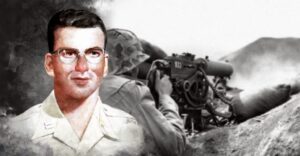 bayonet wounds on his body. Yes, Captain Salomon had died in the battle, but not before he killed 98 enemy soldiers, and the wounded soldiers and the medics with him had all managed to escape. Salomon was a serious force to be reckoned with, as the Japanese found out that day.
bayonet wounds on his body. Yes, Captain Salomon had died in the battle, but not before he killed 98 enemy soldiers, and the wounded soldiers and the medics with him had all managed to escape. Salomon was a serious force to be reckoned with, as the Japanese found out that day.
Medical personnel were considered ineligible for the Medal of Honor at that time, due to the terms of the Geneva Convention, so the request that he be awarded the medal was denied. After numerous other attempts over the years, Salomon’s bravery was finally recognized with the Medal of Honor in 2002, 58 years after his death.
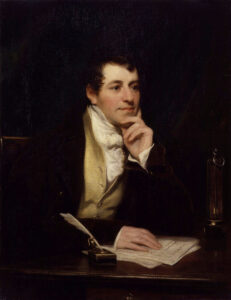 Underground mining, as we all know is dangerous. It was even more dangerous in the 1800s, when the equipment used was much more primitive. Still, many mining companies have switched to open pit mining to avoid the possibility of a cave in. One of the most dangerous forms of underground mining was and still is coal mining. The distinct possibility of a build up of methane gas makes underground coal mining a deadly venture for many miners. Aside from breathing the deadly gas and coal dust, causing death, either instantaneously or later in life…from black lung, the danger of an explosion was always present.
Underground mining, as we all know is dangerous. It was even more dangerous in the 1800s, when the equipment used was much more primitive. Still, many mining companies have switched to open pit mining to avoid the possibility of a cave in. One of the most dangerous forms of underground mining was and still is coal mining. The distinct possibility of a build up of methane gas makes underground coal mining a deadly venture for many miners. Aside from breathing the deadly gas and coal dust, causing death, either instantaneously or later in life…from black lung, the danger of an explosion was always present.
One of the most dangerous parts of underground mining, was the miner’s inability to see, or rather the lanterns used to solve the problem of the miner’s inability to see. It’s pretty difficult to maneuver around in a mine, much less find ore, if you can’t see, and caves don’t generally have built in lights. Miners these days have battery powered lights on their hard hats, but those things didn’t exist in the 1800s. Most generally the miners carried a lantern, filled with heavy vegetable oil and using a wick that was unprotected, thus allowing it to ignite the methane or other flammable gasses, called firedamp or minedamp, lurking undetected in the mine.
The problem needed to be solved, and so several inventors began looking into just how to do that. Probably the best one, at that time, was the Davy lamp. It is a safety lamp designed specifically for use in flammable atmospheres. It was invented in 1815 by Sir Humphry Davy. They didn’t have light bulbs or batteries that could be used in the mines back then. The Davy Lamp consists of a wick lamp with the flame enclosed inside a mesh screen. The mesh screen kept the flame from escaping, thereby reducing the danger of explosions. The Davy Lamp also provided a test for the presence of gases. If flammable gas mixtures were present, the flame of the Davy lamp burned higher with a blue tinge. The lamps were equipped with a metal gauge to measure the height of the flame. When the lamp was placed close to the ground, it could detect gases, such as carbon dioxide, that are more dense than air and so could collect in depressions in the mine. If the lamp determined that the mine air was oxygen-poor (asphyxiant gas), the lamp flame would be extinguished, using a black damp or chokedamp. A methane-air flame is extinguished at about 17% oxygen content…which will still support life, so the lamp gave an early indication of a dangerous atmosphere, allowing the miners to get out before they died of asphyxiation.
Apparently, Davy’s invention was preceded by that of William Reid Clanny, an Irish doctor at Bishopwearmouth, who had read a paper to the Royal Society in May 1813. The Clanny lamp was more cumbersome, but it was successfully tested at Herrington Mill, and he won medals, from the Royal Society of Arts. Another lamp version was the lamp designed by engine-wright George Stephenson. His “Geordie Lamp” drew air in via tiny holes, through which the flames of the lamp could not pass. If you ask me, the metal plate, only allowing small pin points of light would not be a very illuminating. A month before Davy presented his design to the Royal Society, 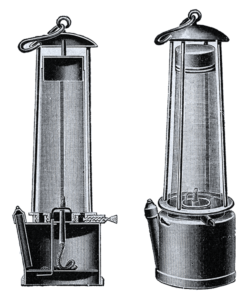 Stephenson supposedly demonstrated his own lamp to two witnesses by taking it down Killingworth Colliery and holding it in front of a fissure from which firedamp was issuing. Unfortunately for Stephenson, Davy beat him to the necessary people.
Stephenson supposedly demonstrated his own lamp to two witnesses by taking it down Killingworth Colliery and holding it in front of a fissure from which firedamp was issuing. Unfortunately for Stephenson, Davy beat him to the necessary people.
The first trial of a Davy lamp with a wire sieve was at Hebburn Colliery on January 9, 1816. Because of its success, Davy was awarded the society’s Rumford Medal. Davy’s lamp differed from Stephenson’s in that the flame was surrounded by a screen of gauze, whereas Stephenson’s prototype lamp had a perforated plate contained in a glass cylinder, which was a design mentioned in Davy’s Royal Society paper, as an alternative to his preferred solution. For his invention Davy was given £2,000 worth of silver. Stephenson, on the other hand, was accused of stealing the idea from Davy. His “Geordie Lamp” had not been demonstrated by Stephenson until after Davy had presented his paper at the Royal Society. While Stephenson was exonerated, Davy went to his grave insisting that he had tried to steal his idea.
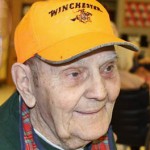
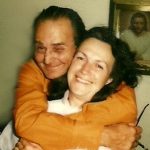 My uncle, Jim Wolfe was a favorite uncle to my sisters, Cheryl Masterson, Caryl Reed, Alena Stevens, Allyn Hadlock, and me. Uncle Jim had a great sense of humor, and a deep sense of family. He loved kids and he was good to all kids. In fact, Uncle Jim was good to everyone. He was the best kind of person. Uncle Jim has a soft heart. Whatever we wanted when we were around Uncle Jim…if he had any say in it, we could have it, or do it! I’m not sure how my parents, Al and Collene Spencer, felt about all that “spoiling,” but I’m sure they were ok with it, because after all, it was only temporary. He just liked to make us happy.
My uncle, Jim Wolfe was a favorite uncle to my sisters, Cheryl Masterson, Caryl Reed, Alena Stevens, Allyn Hadlock, and me. Uncle Jim had a great sense of humor, and a deep sense of family. He loved kids and he was good to all kids. In fact, Uncle Jim was good to everyone. He was the best kind of person. Uncle Jim has a soft heart. Whatever we wanted when we were around Uncle Jim…if he had any say in it, we could have it, or do it! I’m not sure how my parents, Al and Collene Spencer, felt about all that “spoiling,” but I’m sure they were ok with it, because after all, it was only temporary. He just liked to make us happy.
My uncle Jim was a storyteller among storytellers. The best of the best. When Uncle Jim started telling his stories, we all sat around him wide-eyed with wonder. We never knew if his stories were going to be from real life and which ones were going to be tall tales…at least not until the end, when he would tell us the punch line. Then we would all laugh and say, “Oh! Uncle Jim!” He loved to get a little rise out of us, and it really tickled his funny bone. And speaking of tickling, Uncle Jim was a tickler from way back. He used to chase us around and tickle us, if we started bugging him…so naturally, we always started bugging him. Then we would try to get away. Hahahaha!! Not that that ever happened. Uncle Jim had the kindest heart and he was always a lot of fun!
Uncle Jim would help anyone who needed help, if it was within his power…neighbors, friends, and even complete strangers. He was generous, and would always lend a helping hand where he could. He loved his family fiercely and loyally. No one better hurt his wife or kids, in any way. He defended them in word and deed. He was faithful to them in every way. When he decided to buy some land out in Washington, where he would build his final home, he bought enough so that each of his kids could have their own place nearby. He never wanted any of them to not have a home, so he made sure of it. The land he purchased was on he top of a mountain with some of the most beautiful views on the way up. He did his very best for all of his family, and I don’t know anyone who didn’t love Uncle Jim. In his later years, when his care for Alzheimer’s Disease required that he be in a nursing home, Uncle Jim still kept his character. He loved putting a smile on the faces of all the 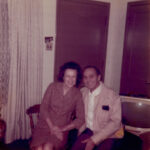
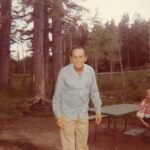 nursing staff, and anyone else who might be there visiting. He could often be found getting into “mischief” behind the nurses station desk, not that he ever hurt anything, he was just “visiting,” after all. My sisters and I love him still! Just thinking about him make us smile. Uncle Jim went to Heaven in 2013 to join his wife, my Aunt Ruth, and other family members who have gone before him. I know they are having a great time, and we are so glad to know where he is, and one day we will be together with him, and all our family again. Today would have been Uncle Jim’s 100th birthday. Happy birthday in Heaven, Uncle Jim. We love and miss you very much.
nursing staff, and anyone else who might be there visiting. He could often be found getting into “mischief” behind the nurses station desk, not that he ever hurt anything, he was just “visiting,” after all. My sisters and I love him still! Just thinking about him make us smile. Uncle Jim went to Heaven in 2013 to join his wife, my Aunt Ruth, and other family members who have gone before him. I know they are having a great time, and we are so glad to know where he is, and one day we will be together with him, and all our family again. Today would have been Uncle Jim’s 100th birthday. Happy birthday in Heaven, Uncle Jim. We love and miss you very much.

